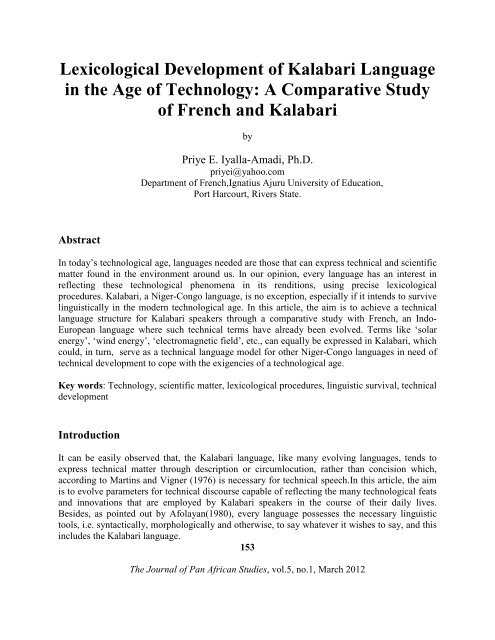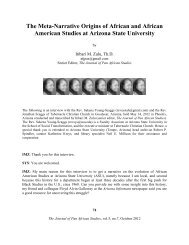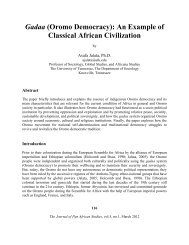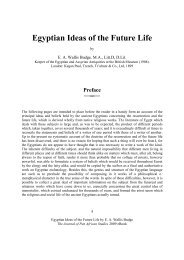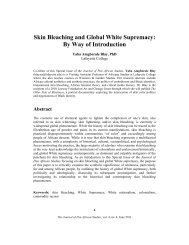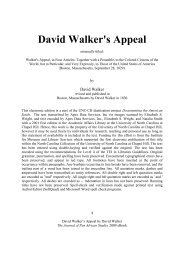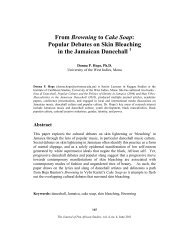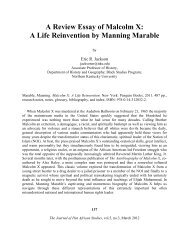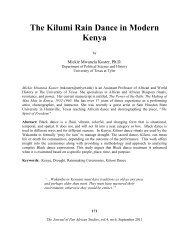Lexicological Development of Kalabari Language in the Age of ...
Lexicological Development of Kalabari Language in the Age of ...
Lexicological Development of Kalabari Language in the Age of ...
You also want an ePaper? Increase the reach of your titles
YUMPU automatically turns print PDFs into web optimized ePapers that Google loves.
<strong>Lexicological</strong> <strong>Development</strong> <strong>of</strong> <strong>Kalabari</strong> <strong>Language</strong><br />
<strong>in</strong> <strong>the</strong> <strong>Age</strong> <strong>of</strong> Technology: A Comparative Study<br />
<strong>of</strong> French and <strong>Kalabari</strong><br />
by<br />
Priye E. Iyalla-Amadi, Ph.D.<br />
priyei@yahoo.com<br />
Department <strong>of</strong> French,Ignatius Ajuru University <strong>of</strong> Education,<br />
Port Harcourt, Rivers State.<br />
Abstract<br />
In today’s technological age, languages needed are those that can express technical and scientific<br />
matter found <strong>in</strong> <strong>the</strong> environment around us. In our op<strong>in</strong>ion, every language has an <strong>in</strong>terest <strong>in</strong><br />
reflect<strong>in</strong>g <strong>the</strong>se technological phenomena <strong>in</strong> its renditions, us<strong>in</strong>g precise lexicological<br />
procedures. <strong>Kalabari</strong>, a Niger-Congo language, is no exception, especially if it <strong>in</strong>tends to survive<br />
l<strong>in</strong>guistically <strong>in</strong> <strong>the</strong> modern technological age. In this article, <strong>the</strong> aim is to achieve a technical<br />
language structure for <strong>Kalabari</strong> speakers through a comparative study with French, an Indo-<br />
European language where such technical terms have already been evolved. Terms like ‘solar<br />
energy’, ‘w<strong>in</strong>d energy’, ‘electromagnetic field’, etc., can equally be expressed <strong>in</strong> <strong>Kalabari</strong>, which<br />
could, <strong>in</strong> turn, serve as a technical language model for o<strong>the</strong>r Niger-Congo languages <strong>in</strong> need <strong>of</strong><br />
technical development to cope with <strong>the</strong> exigencies <strong>of</strong> a technological age.<br />
Key words: Technology, scientific matter, lexicological procedures, l<strong>in</strong>guistic survival, technical<br />
development<br />
Introduction<br />
It can be easily observed that, <strong>the</strong> <strong>Kalabari</strong> language, like many evolv<strong>in</strong>g languages, tends to<br />
express technical matter through description or circumlocution, ra<strong>the</strong>r than concision which,<br />
accord<strong>in</strong>g to Mart<strong>in</strong>s and Vigner (1976) is necessary for technical speech.In this article, <strong>the</strong> aim<br />
is to evolve parameters for technical discourse capable <strong>of</strong> reflect<strong>in</strong>g <strong>the</strong> many technological feats<br />
and <strong>in</strong>novations that are employed by <strong>Kalabari</strong> speakers <strong>in</strong> <strong>the</strong> course <strong>of</strong> <strong>the</strong>ir daily lives.<br />
Besides, as po<strong>in</strong>ted out by Afolayan(1980), every language possesses <strong>the</strong> necessary l<strong>in</strong>guistic<br />
tools, i.e. syntactically, morphologically and o<strong>the</strong>rwise, to say whatever it wishes to say, and this<br />
<strong>in</strong>cludes <strong>the</strong> <strong>Kalabari</strong> language.<br />
153<br />
The Journal <strong>of</strong> Pan African Studies, vol.5, no.1, March 2012
Natural scientific phenomena which pave <strong>the</strong> way for technological <strong>in</strong>ventions abound <strong>in</strong> <strong>the</strong><br />
environment <strong>of</strong> <strong>the</strong> <strong>Kalabari</strong> speaker: <strong>the</strong> sun which can be used power eng<strong>in</strong>es <strong>in</strong> <strong>the</strong> form <strong>of</strong><br />
solar energy; <strong>the</strong> w<strong>in</strong>d which can be converted to w<strong>in</strong>d energy; natural gas which can be made to<br />
produce electricity…., so many technological manifestations which need names. In keep<strong>in</strong>g with<br />
<strong>the</strong> Sapir-Whorf <strong>the</strong>ory, it is <strong>of</strong>ten easier to visualise objects for which <strong>the</strong>re are names.<br />
Therefore, nam<strong>in</strong>g objects <strong>in</strong> <strong>the</strong> natural environment <strong>of</strong> <strong>the</strong> <strong>Kalabari</strong> speaker will supposedly<br />
heighten his awareness <strong>of</strong> <strong>the</strong>m, and <strong>the</strong>reafter give him <strong>the</strong> necessary impulsion to participate <strong>in</strong><br />
creat<strong>in</strong>g and <strong>in</strong>vent<strong>in</strong>g technological th<strong>in</strong>gs for his own comfort and well-be<strong>in</strong>g.<br />
Why a comparative study with French? The reason could be that <strong>the</strong> French language, like a few<br />
o<strong>the</strong>r languages <strong>of</strong> <strong>the</strong> Indo-European family, have benefited from an early <strong>in</strong>dustrial revolution<br />
which has supposedly favoured its correspond<strong>in</strong>g lexical growth. Terms such as “énergie<br />
éolienne” (w<strong>in</strong>d energy), “énergie <strong>the</strong>rmale”, (<strong>the</strong>rmal energy), “champ magnétique”, etc.,<br />
portray a technological awareness that have resulted <strong>in</strong> <strong>the</strong> creation <strong>of</strong> concrete technological<br />
manifestations. However, <strong>in</strong> our op<strong>in</strong>ion, <strong>the</strong> application <strong>of</strong> certa<strong>in</strong> lexicological criteria could<br />
give rise to similar terms <strong>of</strong> technological import <strong>in</strong> o<strong>the</strong>r language families, particularly <strong>the</strong><br />
Niger-Congo family to which <strong>Kalabari</strong> belongs.<br />
Lexicology and Technology<br />
Technological progress is a fact <strong>of</strong> modern life, and all <strong>in</strong>ventions and <strong>in</strong>novations are <strong>the</strong>re to<br />
make life easier for all. No matter where one f<strong>in</strong>ds himself on <strong>the</strong> planet, <strong>the</strong> effects <strong>of</strong> scientific<br />
realities which translate <strong>in</strong>to technological <strong>in</strong>ventions can be felt by all. Realities such as <strong>the</strong> rays<br />
<strong>of</strong> <strong>the</strong> sun which, when harnessed, converts to solar energy and is used to turn turb<strong>in</strong>es, drive<br />
mach<strong>in</strong>es, provide light, etc. This energy that is supplied by <strong>the</strong> sun has been given <strong>the</strong> term<br />
“energie solaire” by <strong>the</strong> French, but how do <strong>the</strong> <strong>Kalabari</strong> call it?<br />
In this article, we adopt <strong>the</strong> perspective <strong>of</strong> Benjam<strong>in</strong> Lee Whorf quoted by Ste<strong>in</strong>er (1998:92)<br />
when he said: “we dissect nature along <strong>the</strong> l<strong>in</strong>es laid down by our native language.” This means<br />
<strong>the</strong>n, that, <strong>in</strong> order to grasp <strong>the</strong> scientific and technological phenomena replete <strong>in</strong> our<br />
environment, we would need a lexicological framework designed to permit <strong>the</strong> creation <strong>of</strong><br />
technical words <strong>in</strong> a technological direction.<br />
We would like to mention at this juncture that <strong>the</strong> concept <strong>of</strong> technology is not new to <strong>the</strong><br />
African. Andah (1992:9) draws attention to <strong>the</strong> fact <strong>the</strong> African has always displayed<br />
technological acumen to cope with his environment. He posits that <strong>the</strong> term technology can be<br />
def<strong>in</strong>ed at two levels: at <strong>the</strong> cultural level where technology can be def<strong>in</strong>ed to mean <strong>the</strong> natural<br />
resources used by man to procure material, social and spiritual objects for his well-be<strong>in</strong>g; and at<br />
<strong>the</strong> physical level where technology represents <strong>the</strong> mental and physical exertions <strong>of</strong> a given race<br />
to master his environment and make <strong>the</strong>m work for him.<br />
154<br />
The Journal <strong>of</strong> Pan African Studies, vol.5, no.1, March 2012
For example, <strong>the</strong> ma<strong>in</strong> occupation <strong>of</strong> <strong>the</strong> <strong>Kalabari</strong> is fish<strong>in</strong>g, and <strong>the</strong> <strong>Kalabari</strong> man has always<br />
displayed mastery <strong>in</strong> <strong>the</strong> art <strong>of</strong> carv<strong>in</strong>g out canoes from whole trees. This he does us<strong>in</strong>g a<br />
technology peculiar to him and this technology is <strong>of</strong>ten transmitted from one generation to<br />
ano<strong>the</strong>r with<strong>in</strong> <strong>the</strong> same family.<br />
But, <strong>in</strong> order to be part <strong>of</strong> a more global culture, names would have to be found or co<strong>in</strong>ed for<br />
o<strong>the</strong>r physical manifestations <strong>of</strong> technology as we know <strong>the</strong>m today. Modern phenomena such as<br />
<strong>the</strong> <strong>in</strong>ternet, mobile telephones, cable networks, etc, would need names <strong>in</strong> all languages. What<br />
<strong>the</strong> African speaker, here represented by <strong>the</strong> <strong>Kalabari</strong> speaker, needs <strong>the</strong>refore, is a<br />
term<strong>in</strong>ological bank <strong>of</strong> l<strong>in</strong>guistically co<strong>in</strong>ed terms for <strong>the</strong> many technological manifestations that<br />
abound all around him and <strong>of</strong> which he is a beneficiary.<br />
One <strong>of</strong> <strong>the</strong> aims <strong>of</strong> this paper is to achieve <strong>the</strong> above by develop<strong>in</strong>g lexicological paradigms<br />
through a comparative study with a language where some <strong>of</strong> <strong>the</strong>se terms already exist. In our<br />
view, lexicology, a discipl<strong>in</strong>e that studies <strong>the</strong> form and mean<strong>in</strong>g <strong>of</strong> words, as well as <strong>the</strong> relations<br />
that exist between <strong>the</strong>m, is well suited to co<strong>in</strong> names for identified phenomena <strong>in</strong> <strong>the</strong> African<br />
environment and ultimately give physical vent to his technological potentials.<br />
Lexicology and Technical Discourse<br />
Accord<strong>in</strong>g to Niklas-Salm<strong>in</strong>en(1997:13), lexicology is <strong>the</strong> branch <strong>of</strong> l<strong>in</strong>guistics which studies <strong>the</strong><br />
lexical units <strong>of</strong> a language by way <strong>of</strong> analys<strong>in</strong>g <strong>the</strong> relations that exist between <strong>the</strong>m. This would,<br />
<strong>in</strong> part, expla<strong>in</strong> <strong>the</strong> choice <strong>of</strong> lexicology as an <strong>in</strong>strument for <strong>the</strong> technical enrichment <strong>of</strong> <strong>the</strong><br />
<strong>Kalabari</strong> language. This choice is also justified by its ability to generate a framework capable <strong>of</strong><br />
produc<strong>in</strong>g technical discourse <strong>in</strong> <strong>the</strong> <strong>Kalabari</strong> language.<br />
What, <strong>the</strong>n, is technical discourse? Vigner and Mart<strong>in</strong> (1976:13) def<strong>in</strong>e it as “a specific code to<br />
express th<strong>in</strong>gs <strong>of</strong> a technical nature. It is a certa<strong>in</strong> type <strong>of</strong> discourse which displays a limited<br />
choice <strong>of</strong> syntactic structures serv<strong>in</strong>g as a base for technical expressions.” Some o<strong>the</strong>r l<strong>in</strong>guists<br />
like Crystal (2007:384) affirm that technical discourse is one whose characteristics are different<br />
from those <strong>of</strong> normal discourse. These <strong>in</strong>clude objectivity, systematic <strong>in</strong>vestigation and exact<br />
measures. There is also an overrid<strong>in</strong>g concern for <strong>the</strong> impersonal, for logical exposition and<br />
precise descriptions.<br />
155<br />
The Journal <strong>of</strong> Pan African Studies, vol.5, no.1, March 2012
Vigner and Mart<strong>in</strong> enumerate some <strong>of</strong> <strong>the</strong> characteristics <strong>of</strong> technical discourse below:<br />
• A near-total absence <strong>of</strong> dist<strong>in</strong>ction between oral and written discourse;<br />
• A homogeneous use <strong>of</strong> language result<strong>in</strong>g <strong>in</strong> <strong>the</strong> absence <strong>of</strong> language registers;<br />
• A reduction <strong>of</strong> temporal forms result<strong>in</strong>g <strong>in</strong> <strong>the</strong> permanence <strong>of</strong> <strong>the</strong> technical fact, and<br />
also a reduction <strong>of</strong> <strong>the</strong> timeless aspect <strong>of</strong> technical operations and <strong>of</strong> <strong>the</strong> properties <strong>of</strong><br />
materials used;<br />
• An objectivity <strong>in</strong> communication which results <strong>in</strong> <strong>the</strong> disappearance <strong>of</strong> all processes<br />
that may entail sentiments or subjective appreciations;<br />
• The precision, as well as <strong>the</strong> concision necessary for technical <strong>in</strong>formation, which is<br />
what makes for <strong>the</strong> use <strong>of</strong> complex lexical units.<br />
As a case <strong>in</strong> po<strong>in</strong>t, how would <strong>the</strong> <strong>Kalabari</strong> speaker express or translate <strong>the</strong> term “refrigerator” <strong>in</strong><br />
his language? A random sampl<strong>in</strong>g among some native <strong>Kalabari</strong> speakers revealed that <strong>the</strong>y had<br />
to th<strong>in</strong>k first <strong>of</strong> <strong>the</strong> concept before attempt<strong>in</strong>g a description us<strong>in</strong>g several lexical items. Answers<br />
<strong>in</strong>cluded:<br />
• Ye obokuma ye (that which makes cold)<br />
• kȩ ye obokuma a ri (what is used to make th<strong>in</strong>gs cold)<br />
• wakȩ ye obokumaar’ bȩ ye ( what we use to keep th<strong>in</strong>gs cold)<br />
• An attempt at concision us<strong>in</strong>g <strong>the</strong> criteria for technical discourse gave us <strong>the</strong> term<br />
“y’obokuma-ye”. Fur<strong>the</strong>r concision would give “obokumaye”. F<strong>in</strong>ally, a<br />
lexicological application gives us a paradigm for o<strong>the</strong>r similar formulations as can be<br />
found <strong>in</strong> <strong>the</strong> table below:<br />
• Obokumaye – réfrigérateur – refrigerator<br />
• Ǫfrimaye - radiateur – radiator<br />
• Samunǫmaye – séchoir – drier<br />
• Gbȩȩye – broyeur – gr<strong>in</strong>der, etc<br />
156<br />
The Journal <strong>of</strong> Pan African Studies, vol.5, no.1, March 2012
Let us proceed to take a l<strong>in</strong>guistic overview <strong>of</strong> <strong>the</strong> two languages <strong>in</strong> this study: French and<br />
<strong>Kalabari</strong>. This is be<strong>in</strong>g done with a view to determ<strong>in</strong>e what l<strong>in</strong>guistic similarities both languages<br />
share that could facilitate technical discourse <strong>in</strong> one or <strong>the</strong> o<strong>the</strong>r.<br />
L<strong>in</strong>guistic Overview <strong>of</strong> French<br />
French is a Romance language which belongs to <strong>the</strong> Italic branch <strong>of</strong> <strong>the</strong> Indo-European family <strong>of</strong><br />
languages, a family which groups toge<strong>the</strong>r about a thousand languages, spoken by approximately<br />
three million <strong>in</strong>dividuals (Crystal, 2007:). Accord<strong>in</strong>g to Crystal, <strong>the</strong> phenomenon <strong>of</strong> <strong>the</strong><br />
popularity <strong>of</strong> French is due <strong>in</strong> part to autochthony (about 200 million native speakers <strong>in</strong> Europe),<br />
and due <strong>in</strong> part to a heritage <strong>of</strong> colonization (about 500 million Francophone speakers <strong>in</strong> <strong>the</strong><br />
world).<br />
At <strong>the</strong> syntactic level, French has a configuration <strong>of</strong> Subject-Verb-Object (S-V-O) <strong>in</strong> its basic<br />
constituents (Harris, 1987:28), as <strong>in</strong> <strong>the</strong> example:<br />
Pierre regarde Marie<br />
At <strong>the</strong> morphological level, suffixation appears to be <strong>the</strong> most productive derivational process <strong>in</strong><br />
French. The process consists <strong>in</strong> add<strong>in</strong>g affixes to <strong>the</strong> base <strong>of</strong> pre-exist<strong>in</strong>g words. In technical<br />
vocabulary, this gives a paradigm <strong>of</strong> words like:<br />
• Radier + tion = radiation<br />
• Souder + age = soudage<br />
• Efficace + ité = efficacité, etc.<br />
Phonologically, French is a tonal language which makes use <strong>of</strong> accent marks to guide<br />
pronunciation and <strong>the</strong> mean<strong>in</strong>g <strong>of</strong> words. There are three ma<strong>in</strong> accents, and <strong>the</strong>y <strong>of</strong>ten serve to<br />
differentiate words accord<strong>in</strong>g to which accents are placed on <strong>the</strong>m:<br />
• The low accent (accent grave) – à, è, ù as <strong>in</strong> à, zèbre, où ;<br />
• The high accent (accent aigu) – é as <strong>in</strong> été, répété;<br />
• The circumflex accent (â, ê, î, ô, û) as <strong>in</strong> hâte, bête, gîte, hotel, mûr.<br />
157<br />
The Journal <strong>of</strong> Pan African Studies, vol.5, no.1, March 2012
L<strong>in</strong>guistic Overview <strong>of</strong> <strong>Kalabari</strong><br />
The <strong>Kalabari</strong> language is one <strong>of</strong> <strong>the</strong> ijoid languages <strong>of</strong> <strong>the</strong> Niger-Congo family <strong>of</strong> languages.<br />
More specifically, it belongs to <strong>the</strong> East Ijo group. Accord<strong>in</strong>g to Williamson and Timitimi (1983)<br />
and later Jenewari (1989), o<strong>the</strong>r members <strong>of</strong> this group are Okrika, Ibani, Bille and perhaps<br />
Nkoro. Dapper (2003) likewise affirms that <strong>Kalabari</strong> is one <strong>of</strong> <strong>the</strong> Ijaw tribes that live <strong>in</strong> <strong>the</strong><br />
Niger-Delta region. Among <strong>the</strong>se languages, we have Izon, Nembe, Bille, Kula, Ibani, Tombia,<br />
Okrika, etc. Speakers can be found everywhere <strong>in</strong> <strong>the</strong> world but more specifically <strong>in</strong> a state<br />
called Rivers <strong>in</strong> Nigeria, West Africa.<br />
Concern<strong>in</strong>g <strong>the</strong> orthography <strong>of</strong> <strong>Kalabari</strong>, Harry (2005) <strong>in</strong>forms that <strong>the</strong> first <strong>in</strong>dividual attempts<br />
<strong>in</strong> this direction were <strong>in</strong> 1949 when B.A. Harry published a primer with <strong>the</strong> title “<strong>Kalabari</strong>tari go<br />
diri”(<strong>Kalabari</strong> Primer), followed by ano<strong>the</strong>r primer, this time written by N.T. Akobo <strong>in</strong> 1953<br />
with <strong>the</strong> title “Wanim<strong>in</strong>’ibiai”(Th<strong>in</strong>gs we ought to know). It was only after <strong>the</strong>se <strong>in</strong>dividual<br />
efforts that <strong>the</strong> government sponsored orthography projects <strong>in</strong> <strong>in</strong>digenous languages, <strong>the</strong>reby<br />
pav<strong>in</strong>g <strong>the</strong> way for primers <strong>in</strong> <strong>Kalabari</strong> written by erudite scholars like Berepiki (1971),<br />
Williamson (1972) and Jenewari (1972). Recently, some speakers have been us<strong>in</strong>g more modern<br />
means to diffuse <strong>the</strong> language. Such is <strong>the</strong> case <strong>of</strong> DawariBraide whose electronic English-<br />
<strong>Kalabari</strong> dictionary can be consulted onl<strong>in</strong>e us<strong>in</strong>g <strong>the</strong> <strong>in</strong>ternet.<br />
At <strong>the</strong> phonological level, <strong>Kalabari</strong> is a tonal language like French. Harry (2005) expla<strong>in</strong>s that<br />
words <strong>in</strong> <strong>the</strong> language are produced with <strong>the</strong> use <strong>of</strong> pitch <strong>in</strong> comb<strong>in</strong>ation with sound segments<br />
(vowels and consonants). Certa<strong>in</strong> similarities can be observed between <strong>the</strong> two languages <strong>of</strong><br />
study. For example, <strong>the</strong> phonetic symbols <strong>of</strong> [i] and [ε] represent <strong>the</strong> same sounds <strong>in</strong> both<br />
languages as <strong>in</strong> ‘ici’ [isi] (French) and ‘igoni’ [igoni] (<strong>Kalabari</strong>); ‘frère’ [frεr] (French) and ‘lȩgi’<br />
[lεgi] (<strong>Kalabari</strong>). However, it would be noted that <strong>in</strong> <strong>the</strong> second example, <strong>Kalabari</strong> uses a<br />
diacritic sign ‘ȩ’ where French uses a low accent ‘è’ to represent <strong>the</strong> same sound.<br />
Diacritic signs or marks are actually signs which, when added to a letter, modify its value, or<br />
allow to dist<strong>in</strong>guish between two homographs (homographic words). Accord<strong>in</strong>g to Dapper<br />
(2003), <strong>the</strong>se marks make it possible to dist<strong>in</strong>guish between <strong>the</strong> follow<strong>in</strong>g letters <strong>in</strong> <strong>the</strong> <strong>Kalabari</strong><br />
alphabet and <strong>the</strong>ir resultant change <strong>in</strong> mean<strong>in</strong>g:<br />
• b; ḇ as <strong>in</strong> bele; ḇele (clear; shift)<br />
• d; ḏ as <strong>in</strong> de<strong>in</strong>; ḏima (peace; change)<br />
• e; ȩ as <strong>in</strong> mie; miȩ (this, do)<br />
• i; ḭ as <strong>in</strong> iri; ḭrḭa (dry; young girl)<br />
• o; ǫ as <strong>in</strong> obiri; ǫḇǫkǫ (dog; chicken)<br />
• u; ų as <strong>in</strong> ikulele; ikųta (iron; coral bead).<br />
158<br />
The Journal <strong>of</strong> Pan African Studies, vol.5, no.1, March 2012
In its syntactic configuration, <strong>Kalabari</strong> is S-O-V, i.e. Subject-Object-Verb, unlike French which<br />
is S-V-O. A few examples may suffice to illustrate this:<br />
French: Je regarde Boma (I look at Boma)<br />
<strong>Kalabari</strong>: A Boma diki ar’ (I Boma look at)<br />
The above is an important po<strong>in</strong>t to note dur<strong>in</strong>g lexicological formulations. For example, to say<br />
‘énergie solaire’ (noun + adjective), <strong>the</strong> native <strong>Kalabari</strong> speaker would give a nom<strong>in</strong>al phrase ‘<br />
irua bȩ krǫ’ (Noun + Conj + Noun).<br />
However, <strong>in</strong> spite <strong>of</strong> <strong>the</strong> various efforts mentioned above, <strong>Kalabari</strong> orthography is yet to be<br />
standardised. It is <strong>the</strong>refore still possible to propose lexicological models that will permit<br />
technical discourse and words <strong>of</strong> technological import <strong>in</strong> <strong>the</strong> <strong>Kalabari</strong> language before its<br />
standardisation.<br />
<strong>Lexicological</strong> Paradigms for Technical Discourse<br />
By ‘lexicological paradigms’, we mean l<strong>in</strong>guistic strategies that are adopted to develop technical<br />
language models <strong>in</strong> a language. While carry<strong>in</strong>g out a study on <strong>the</strong> technical development <strong>of</strong> <strong>the</strong><br />
Yoruba language, Iyalla-Amadi (2000:89) was able to formulate what she called lexicological<br />
procedures. Some <strong>of</strong> <strong>the</strong>se <strong>in</strong>clude:<br />
i. Nom<strong>in</strong>alization: a procedure which consists <strong>in</strong> transform<strong>in</strong>g whole sentences or groups <strong>of</strong><br />
words <strong>in</strong>to a noun phrase. This can be done through <strong>the</strong> affixal process <strong>of</strong> add<strong>in</strong>g a prefix<br />
or a suffix;<br />
ii. Special co<strong>in</strong>ages: <strong>the</strong>se are words that are formed or co<strong>in</strong>ed us<strong>in</strong>g <strong>the</strong> l<strong>in</strong>guistic resources<br />
<strong>of</strong> <strong>the</strong> language to reflect words with scientific or technological import;<br />
iii. Adjectival constructions: <strong>the</strong>se are basically grammatical constructions result<strong>in</strong>g from <strong>the</strong><br />
juxtaposition <strong>of</strong> adjectives and nouns. Khamisi (1990) refers to <strong>the</strong>m as ‘syntactic<br />
strategies’;<br />
iv. Phonologically <strong>in</strong>tegrated loanwords: <strong>the</strong>se describe loanwords from contiguous<br />
languages to reflect a larger global culture but adapted to <strong>the</strong> phonological structure <strong>of</strong><br />
<strong>the</strong> source language.<br />
Let us proceed to apply some <strong>of</strong> <strong>the</strong> above-mentioned procedures to <strong>the</strong> formulation <strong>of</strong><br />
technological terms <strong>in</strong> <strong>Kalabari</strong>, draw<strong>in</strong>g from <strong>the</strong> French language. First, a lexicological model<br />
for <strong>the</strong> term ‘énergie’ (energy):<br />
159<br />
The Journal <strong>of</strong> Pan African Studies, vol.5, no.1, March 2012
A. Energie solaire (French) – irua ḇų ḇoḇȩkrǫ ; irua iḏa krǫ<br />
Sometimes, native <strong>Kalabari</strong> speakers refer to ‘electricity’ as ‘iḏakrǫ’, mean<strong>in</strong>g that which<br />
draws its energy from <strong>the</strong> elements. This is why this term has been attached to <strong>the</strong> shorter<br />
translation. In keep<strong>in</strong>g with <strong>the</strong> exigencies <strong>of</strong> technical discourse, however, we shall apply<br />
<strong>the</strong> third lexicological procedure <strong>of</strong> adjectival constructions to propose <strong>the</strong> follow<strong>in</strong>g term:<br />
‘iruakrǫ’.<br />
This gives rise to a lexicological paradigm for o<strong>the</strong>r technical terms as follow:<br />
• Énergie solaire – irua krǫ (solar energy)<br />
• Énergie éolienne – fȩrų krǫ (w<strong>in</strong>d energy)<br />
• Énergie ligneuse - s<strong>in</strong>ḇuḇȩ krǫ (ligneous energy)<br />
• Energie fossile - kiriḇųḇȩ krǫ<br />
• Energie <strong>the</strong>rmale – kir’ǫfiri krǫ<br />
• Energie renouvelable - ojuḏ<strong>in</strong>ma krǫ, etc.<br />
B. Aimant (French) – yekpapu a ri (<strong>Kalabari</strong>)<br />
This word means ‘magnet’ and <strong>the</strong> concept is one <strong>of</strong> a powerful object which attracts o<strong>the</strong>r<br />
objects to itself. Here, magnetism is be<strong>in</strong>g referred to as a technological phenomenon. From<br />
this perspective, <strong>the</strong> semantic field <strong>of</strong> <strong>the</strong> word can first be determ<strong>in</strong>ed and <strong>the</strong>n <strong>the</strong> term<br />
rendered more concise by reduc<strong>in</strong>g it to a s<strong>in</strong>gle lexical item ‘kpapu’. F<strong>in</strong>ally, <strong>the</strong><br />
lexicological procedures <strong>of</strong> nom<strong>in</strong>alization and adjectival constructions can be applied to<br />
arrive at <strong>the</strong> follow<strong>in</strong>g paradigm:<br />
• Aimant – kpapu (magnet)<br />
• Magnétisme – kpapu-bra (magnetism)<br />
• Champ magnétique – kpapu yiyǫ (magnetic field)<br />
• Champ électromagnétique - iḏa-kpapu-yǫ (magnetic field)<br />
• Rayon électromagnétique - iḏa-kpapu tungbali (magnetic ray), etc.<br />
C. Technologie – àkà na gbolomaaayi (technology)<br />
Here, we have chosen to evolve an <strong>in</strong>digenous term for <strong>the</strong> concept which is <strong>the</strong> ma<strong>in</strong><br />
preoccupation <strong>of</strong> this paper. But, is this term really an imported one or is it simply one<br />
which expresses <strong>the</strong> manifestations <strong>of</strong> <strong>the</strong> applications <strong>of</strong> science to everyday<br />
phenomena? Therefore, go<strong>in</strong>g by <strong>the</strong> assumptions <strong>of</strong> <strong>the</strong> Sapir-Whorf Hypo<strong>the</strong>sis, if <strong>the</strong><br />
<strong>in</strong>digenous <strong>Kalabari</strong> speaker is able to evolve an <strong>in</strong>digenous term that will permit him to<br />
visualize, <strong>in</strong> a vivid manner, <strong>the</strong> effects <strong>of</strong> <strong>the</strong> concept <strong>of</strong> technology, he would be <strong>in</strong> a<br />
position to participate fully <strong>in</strong> <strong>the</strong> <strong>in</strong>ventions <strong>of</strong> <strong>the</strong> technological age <strong>in</strong> which he f<strong>in</strong>ds<br />
himself.<br />
160<br />
The Journal <strong>of</strong> Pan African Studies, vol.5, no.1, March 2012
Of course, it would be easier to borrow words from <strong>the</strong> contiguous Indo-European<br />
language and phonologically <strong>in</strong>tegrate <strong>the</strong>m <strong>in</strong>to <strong>the</strong> <strong>in</strong>digenous language (as is <strong>the</strong><br />
current practice, e.g. technology - tȩk<strong>in</strong>ǫlǫji), but this procedure would not produce <strong>the</strong><br />
desired technological impetus <strong>in</strong> <strong>Kalabari</strong> speakers. Ra<strong>the</strong>r, it would lead to fur<strong>the</strong>r<br />
lexical paucity that might ultimately retard <strong>the</strong> much sought technological progress.<br />
In <strong>the</strong> light <strong>of</strong> <strong>the</strong> above, <strong>the</strong>refore, <strong>the</strong> lexicological strategy <strong>of</strong> special co<strong>in</strong>ages has been<br />
adopted to arrive at <strong>the</strong> follow<strong>in</strong>g term:<br />
Technology – akàbàayi.<br />
It should be noted that most <strong>of</strong> <strong>the</strong> terms proposed here are subject to fur<strong>the</strong>r review <strong>in</strong><br />
<strong>the</strong> language. This is embryonic work which is designed to start <strong>of</strong>f <strong>the</strong> lexicological<br />
process <strong>of</strong> formulat<strong>in</strong>g <strong>in</strong>digenous terms with technological import. It can only be hoped<br />
that <strong>the</strong> proposed terms would br<strong>in</strong>g about <strong>the</strong> needed constructive controversy for<br />
l<strong>in</strong>guistic growth <strong>in</strong> a scientific and technological direction <strong>in</strong> <strong>the</strong> <strong>Kalabari</strong> language.<br />
Conclusion<br />
In this study, a comparative study between languages <strong>of</strong> two different l<strong>in</strong>guistic families<br />
has enabled us to def<strong>in</strong>e and explore areas <strong>of</strong> similarities and differences which could<br />
allow lexicological paradigms for technological terms. The study has also made it<br />
possible to take cognizance <strong>of</strong> similarities that could lead to technical discourse with <strong>the</strong><br />
desired result – br<strong>in</strong>g<strong>in</strong>g about a technological consciousness which would permit<br />
technical expression <strong>in</strong> a Niger-Congo language <strong>of</strong> ijoid orig<strong>in</strong> such as <strong>Kalabari</strong>.<br />
As has been mentioned several times <strong>in</strong> this article, <strong>the</strong> ability to name technological<br />
feats is a def<strong>in</strong>ite step towards creat<strong>in</strong>g technological facts. The focus <strong>of</strong> this paper was<br />
<strong>the</strong>refore <strong>the</strong> provision <strong>of</strong> <strong>the</strong> requisite l<strong>in</strong>guistic tools for <strong>the</strong> <strong>Kalabari</strong> speaker to be a<br />
conscious participant <strong>in</strong> <strong>the</strong> current technological era, us<strong>in</strong>g lexicological procedures.<br />
Be<strong>in</strong>g able to express such terms as ‘w<strong>in</strong>d energy’, ‘electromagnetic field’, ‘technological<br />
progress’, etc., <strong>in</strong> his native tongue would enable <strong>the</strong> speaker, whe<strong>the</strong>r French or<br />
<strong>Kalabari</strong>, to first take cognizance <strong>of</strong> <strong>the</strong>se phenomena <strong>in</strong> his environment, and <strong>the</strong>n strive<br />
to manifest <strong>the</strong>m through <strong>in</strong>ventions. It all starts with <strong>the</strong> language.<br />
For us <strong>in</strong> this paper, <strong>the</strong> lexicological development <strong>of</strong> <strong>Kalabari</strong>, an ijoid language <strong>of</strong> <strong>the</strong><br />
Niger-Congo family, <strong>in</strong> comparison with French, a Romance language <strong>of</strong> <strong>the</strong> Indo-<br />
European family, constitutes an important launch<strong>in</strong>g pad to catapult <strong>the</strong> former <strong>in</strong>to <strong>the</strong><br />
technological age <strong>of</strong> <strong>the</strong> present century. This is perhaps what <strong>the</strong> <strong>Kalabari</strong> speaker, and<br />
by extension, o<strong>the</strong>r speakers <strong>of</strong> <strong>the</strong> Niger-Congo phylum would need to be fully part <strong>of</strong><br />
<strong>the</strong> technological <strong>in</strong>ventions <strong>of</strong> his times as a world citizen.<br />
161<br />
The Journal <strong>of</strong> Pan African Studies, vol.5, no.1, March 2012
References<br />
Afolayan, A. (1980). ‘Mo<strong>the</strong>r-Tongue <strong>in</strong> Primary School: The Ife Six-Year Project’.<br />
EDUCAFRICA 6: 50-65.<br />
Andah, B.W. (1992). Nigeria’s Indigenous Technology. Ibadan:Ibadan University Press.<br />
Berepiki, C.I. (1971). <strong>Kalabari</strong> Tari Go Diri. Ibadan & Port Harcourt: Rivers Readers<br />
Project.<br />
Crystal, D. (2003). The Cambridge Encyclopedia <strong>of</strong> <strong>Language</strong>.2 nd<br />
Cambridge University Press.<br />
Ed. New York:<br />
Dapper, G.C. (2003).<strong>Kalabari</strong> Companion. North Carol<strong>in</strong>a: Pr<strong>of</strong>essional Press.<br />
Harris, M. (1987).‘French’.In The World’s Major <strong>Language</strong>s.Ed. Bernard Comrie.<br />
London & New York: Routledge.<br />
Harry, G.O. (2005). ‘Aspects <strong>of</strong> <strong>the</strong> Tonal System <strong>of</strong> <strong>Kalabari</strong>-Ijo’.CSLI Stanford<br />
Monographs <strong>in</strong> African <strong>Language</strong>. 12 – 44.<br />
Iyalla-Amadi, P.E. (2000). Technical Translation <strong>of</strong> French Energy Terms <strong>in</strong>to Yoruba:<br />
A <strong>Lexicological</strong> Framework for African Technological <strong>Development</strong>. PhD<br />
dissertation, University <strong>of</strong> Ibadan.<br />
Jenewari, C.E.W. (1972). Teachers’ Notes on <strong>Kalabari</strong> Tari Go Diri. Ibadan & Port<br />
Harcourt: Rivers Readers Project.<br />
Jenewari.C.E.W. (1989).‘Ijoid’.In The Niger-Congo <strong>Language</strong>s. Ed. J.T. Bendor-<br />
Samuel.University Press <strong>of</strong> America. 105 – 118.<br />
Khamisi, A.M. (1990). ‘Syntactic Structures <strong>in</strong> Translation’.FIT Newsletter IX: 52-68.<br />
Niklas-Salm<strong>in</strong>en, A. (1997). La lexicologie. Paris : Armand Col<strong>in</strong>/Masson.<br />
Sapir, E. (1921). <strong>Language</strong>.New York : Harcourt Brace.<br />
Ste<strong>in</strong>er, G. (1998). After Babel: Aspects <strong>of</strong> <strong>Language</strong> and Translation. 3rd Ed. Oxford &<br />
New York: Oxford University Press.<br />
162<br />
The Journal <strong>of</strong> Pan African Studies, vol.5, no.1, March 2012
Vigner, G. & Mart<strong>in</strong>, A. (1976).Le français technique. Paris: Hachette/Larousse.<br />
Whorf, B. L. (1958). <strong>Language</strong>, Thought and Reality.New York: Wiley & Sons; London:<br />
Chapman & Hall.<br />
Williamson, K. & Timitimi, A.O. (1983). Introduction. In Short Izǫn-English<br />
Dictionary.Port Harcourt: University <strong>of</strong> Port Harcourt Press, ix – lxviii.<br />
163<br />
The Journal <strong>of</strong> Pan African Studies, vol.5, no.1, March 2012


